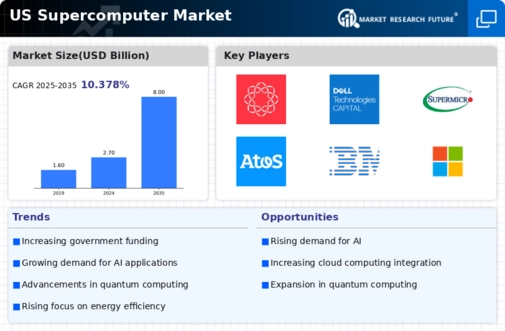The supercomputer market is characterized by intense competition and rapid technological advancements, driven by the increasing demand for high-performance computing across various sectors, including scientific research, artificial intelligence, and big data analytics. Major players such as NVIDIA (US), IBM (US), and Hewlett Packard Enterprise (US) are at the forefront, each adopting distinct strategies to enhance their market positioning. NVIDIA (US) focuses on innovation in GPU technology, which is pivotal for AI and machine learning applications, while IBM (US) emphasizes hybrid cloud solutions and quantum computing integration. Hewlett Packard Enterprise (US) is leveraging its expertise in high-performance computing to cater to the growing needs of enterprises seeking advanced data processing capabilities. Collectively, these strategies contribute to a competitive landscape that is both dynamic and multifaceted.
In terms of business tactics, companies are increasingly localizing manufacturing and optimizing supply chains to enhance operational efficiency and reduce costs. The market structure appears moderately fragmented, with several key players exerting substantial influence. This fragmentation allows for a diverse range of offerings, catering to various customer needs, while also fostering innovation as companies strive to differentiate themselves in a crowded marketplace.
In November 2025, NVIDIA (US) announced a strategic partnership with a leading research institution to develop next-generation AI supercomputing systems. This collaboration is expected to accelerate advancements in AI research and applications, positioning NVIDIA as a leader in the integration of AI with supercomputing technologies. The partnership underscores the importance of collaboration in driving innovation and meeting the evolving demands of the market.
In October 2025, IBM (US) unveiled its latest quantum computing initiative, aimed at enhancing the capabilities of its supercomputing systems. This initiative is significant as it not only reinforces IBM's commitment to quantum technology but also highlights the growing intersection of quantum computing and traditional supercomputing. By integrating these technologies, IBM seeks to offer unparalleled computational power, which could redefine problem-solving in complex scientific and industrial applications.
In September 2025, Hewlett Packard Enterprise (US) launched a new line of supercomputers designed specifically for edge computing environments. This move is particularly relevant as it addresses the increasing demand for processing power at the edge, where data is generated. By focusing on edge computing, HPE is positioning itself to capture a growing segment of the market that requires real-time data processing capabilities, thereby enhancing its competitive edge.
As of December 2025, current trends in the supercomputer market are heavily influenced by digitalization, sustainability, and the integration of AI technologies. Strategic alliances are becoming increasingly vital, as companies recognize the need to collaborate to leverage complementary strengths. Looking ahead, competitive differentiation is likely to evolve from traditional price-based competition to a focus on innovation, technological advancements, and supply chain reliability. This shift suggests that companies that prioritize R&D and strategic partnerships will be better positioned to thrive in an ever-evolving market.





















Leave a Comment